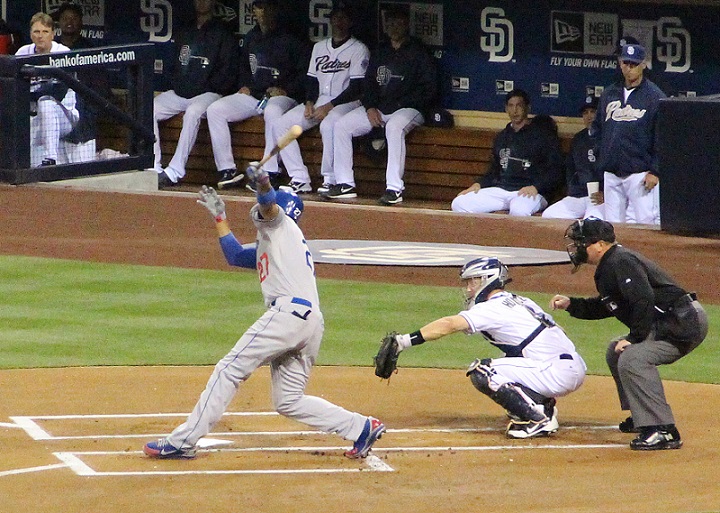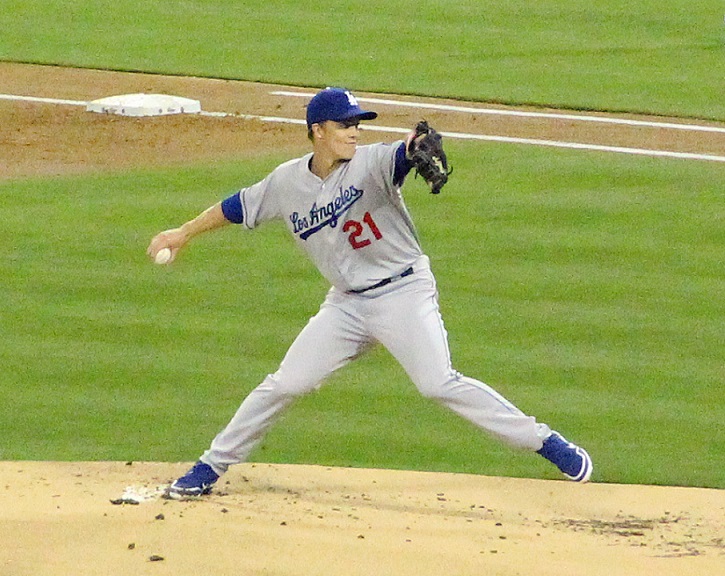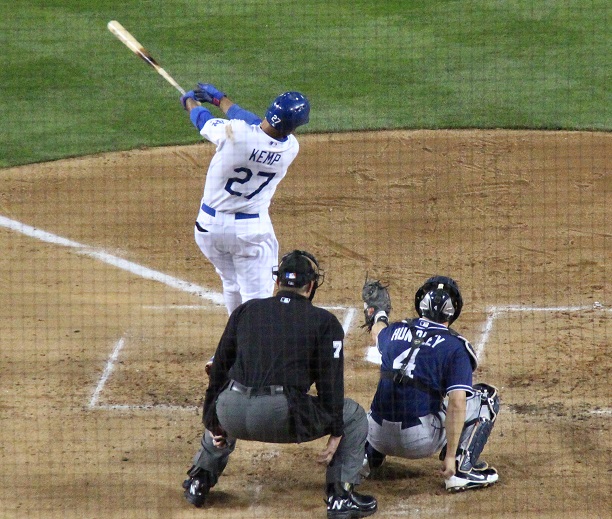A big topic of discussion in the early part of this season has been the focus on the dreaded ´S´ word . . . slump. . . particularly as it relates to Matt Kemp. It appears he has started to get his swing back, hitting his first home run of the season against the Mets this week. But it begs the question: How can a world beater turn into whiffer so quickly?

It was swings like this that kept Dodger slugger Matt Kemp mired in a slump through the first three weeks of the season. (Photo credit – Ron Cervenka)
A slump is a tricky combination of mental, mechanical, and most importantly rhythmical issues. Every player breaks out of a slump differently but there are some aspects that are common to the Little Leaguers all the way up to the big leaguers.
Mental – A slump compounds rather quickly in the mind especially with 50,000 people watching. You start to struggle with a few bad days. You begin to feel the pressure to perform to expectations. You don’t recognize the good pitch or you foul it off. You start to push even more, flailing at pitches out of the strike zone. Pitchers take advantage of your situation by exploiting your weakness. Your mechanics change. Outs rack up and the average plunges. You doubt your ability and lose confidence. The downward cycle begins. Kemp’s frustration has been palpable this spring and you could see his posture change as the slump continued.
Mechanical – This is the easiest element to recognize. When you get down to basics, batting is very simple (in theory) — you need to get that bat at a perfect 90 degree angle as the ball arrives in the hitting zone. There are lots of ways to get the bat to the hitting zone but it has to be there at the right angle to have success. If you hit the ball perfectly, the ball should go right back to the pitcher. If your bat angle is off, the barrel is usually getting through too quickly on the off speed pitch or not quickly enough on the fastball. Bad bat angle causes hard fouls or weak ground balls to the pull hand and easy pop flies to the opposite field. We witnessed these results repeatedly with Kemp. He hit into easy double plays pulling weak grounders to the 3B or SS with the mid-plate to inside pitch or weakly popping up the mid to outside pitch to the second baseman, first baseman or right fielder.
Rhythmical – This is the true “inner zen” of baseball of which few speak but great players master. Baseball is a war of competing rhythms, paces, and cadences. The sound of the ball off the bat and the skips produced on the ground allow a fielder to time and catch a ground ball. A pitcher tries to fool the batter by modifying his pace, location, and mechanical rhythm. A batter wants to perceive and assimilate the pace at which the ball arrives to the plate to gauge his swing. Success in baseball is intricately linked to perception of rhythm – on the field, at the plate, or on the mound. If you have an understanding of baseball rhythm and know how you can manipulate it, the baseball world is your oyster. You can dominate. If you do not, you will struggle.
Having the limited opportunity to really watch Zack Greinke pitch this season, it has been truly amazing to see how he dominates batters with his own personal pace, focus, and rhythm. He works quickly and efficiently, never letting the batter feel comfortable at the plate. As a pitcher, I enjoy watching him work batters while maintaining his relaxed demeanor. It is a very passive-aggressive style that is aggravating as a batter as I am sure Carlos Quentin can tell you. When he is on (and even when he is not), you can really feel the pace that he imposes on the mound, keeping the batter just slightly off balance.

Former Cy Young Award winner Zack Greinke works very quickly and efficiently, which causes batters to feel uncomfortable at the plate. (Photo credit – Ron Cervenka)
From the batter’s perspective, a breakdown in the perception and assimilation of the pace of a pitched ball is the problem that causes almost all batting problems. There is a palpable rhythm to each type of pitch that a hitter must gauge to get the bat in motion. One classic rhythm problem that causes mechanical issues with Little League batters is “pulling the head.” This is really not the problem by itself but a symptom of the bigger problem. Your pace is off, your body and hips open early, your hands follow too quickly and the head flies off the ball. The head is the last part in the chain of more important prior events. Kemp’s head was flying on many off-speed pitches but the real problem was that his hips were opening early. This caused a lot of his early struggles at the plate.

In this strikeout, Kemp’s hips opened very early causing his head to fly off the ball which, of course, is already in Nick Hundley’s glove. (Photo credit – Ron Cervenka)
Slump Remedies – Somehow you have to find a way to break out of the vicious cycle. I am sure you can remember Jason Giambi’s famous unorthodox “gold thong remedy.” He broke his cycle by wearing this uncomfortable garment to change his focus. Apparently it worked. Some players need to be distracted and others need to focus.
With little leaguers, it is usually a problem of focus. I try to get my kids here in Mexico to do their own routine at the plate that reinforces batting mechanics and establishes their personal rhythm. Nomar Garciaparra was famous for his meticulous routine of checking his batting gloves and following an exact series of movements. This may have seemed like silly superstition but what he was establishing and maintaining was his personal cadence. This type of routine helps kids as well in establishing their internal cadence that they will need to perceive the pitcher’s rhythm and hit successfully. This is also reinforced by refraining from swinging on the first few pitches to perceive the pitcher’s rhythm before attempting to hit. Sometimes in practice, I have the kids simply watch pitches at the plate while visualizing their swing to practice their perception of cadence.
The best slump remedy for professional hitters that I have seen is what Kemp has been doing recently — staying off the inside pitch, avoiding the temptation to pull the ball, having patience at the plate, and waiting for good pitches on the outer half of the plate to drive to right field. These elements force you to keep your body closed and maintain your hands back as long as possible. This is the foundation of the Adrian Gonzalez hitting philosophy which facilitates his success against left-handed pitching and tends to minimize any potential slumps during the season. It is one of the reasons why he is a truly great hitter. This philosophy appears to be rubbing off on Kemp (and I am sure reinforced by hitting coach Mark McGwire). Over the past series, we have seen Kemp begin to successfully drive the ball to right. Hopefully this means he is out of his slump and has gotten his rhythmical “batting zen” back.




 April 28th, 2013 at 6:00 am
April 28th, 2013 at 6:00 am  by Robb Anderson
by Robb Anderson  Posted in
Posted in 

A very well written and extremely cerebral article, Robb – Thanks!
I love the Little League connection. It is amazing how the things that we were taught as Little Leaguers still apply in professional baseball as well.
I agree that Kemp seems to be coming out of his slump but fear that Luis Cruz is slumping his way back to Albuquerque. I anticipate that he will be involved in a roster move when Hanley returns in a few days.
The guy who I am most impressed with is Justin Sellers. In watching Justin closely (as I have for the past two seasons), he is utilizing many of the remedies that you mentioned in your article and they seem to be paying off for him.
Thanks again for the great article – I anxiously await your next one.
I am very concerned about Cruz. We have been big supporters of him here in Mexico and were pleased with his great half season last year but he appears to be lost at the plate. He doesn’t have the luxury of being able to work it out like Kemp. He has never been a selective hitter, taking very few walks but he is now swinging at almost everything. I can’t recall one good hard ball he has hit this year. He is not taking any pitches and he looks off balance at the plate mostly hitting soft flies or easily caught foul balls.
I have noticed Sellers hitting more line drives to the opposite field as of recent. If he keeps that up, it will benefit him in his career. He has a great glove but his stick has always been the concern. My biggest pet peeve with him is that if he gets lucky enough to hit one out of the park afterwards “homerun-itis” starts to appear with a big monster swing. He is not a home run hitter but could be a decent line drive hitter. In any event, should be interesting when Hanley gets back to see what happens.
Excellent article Robb. The baseball hitter’s slump is the most difficult in all of sports, IMO. That is simply because hitting the baseball is the most difficult task in all of sports. The hitter can be derailed as you point out mentally, mechanically and rhythmically. It is so very difficult to replicate the perfect swing for a hitter. It would be easy if they were hitting off a tee every time.
Hopefully Hanley can find his perfect swing quickly. The team needs it.
It is beginning to look like Luis Cruz might have been a one year wonder. Perhaps the league simply has caught up to him. As unfortunate as it is the team needs more production from Cruz or anyone replacing him. His time on the Dodger roster may well be limited.
I have a gut feeling that this is going to be Hanley’s year to return to all-star form. He was hitting the ball well in WBC and now appears to be hitting just as well in Rancho. Just a hunch but I think he is going to look good this year at the plate, in the field at SS may be something else.
Nice break down Robb. I’m getting impatient waiting for the McGwire philosophy to start rubbing off on the team. When it happens; look out!
Great article Robb. Lets hope that McGwire can get the job done and show these guys the way to the promised land. As far a Cruz is concerned I completely agree he pressing to much and just looks lost at the plate. I think a big problem might be that he’s out of options and can’t be sent down without his permission. We could easily lose him to another team. My guess is he becomes trade bait !! Right now I’m liking Hairston at 3B. We give up a little bit of defense but he’s a lot more dependable at the plate.
Hairston: .167 / .184 / .194 / .379
Cruz: .098 / .130 / .098 .228
I must be missing the “a lot.”
Look for the “hot hitting” Juan Uribe (.214 / .421 / .429 / .850) to see the most playing time at 3B.
to see the most playing time at 3B.
My Bad, I meant Punto
400 .500 .433 .933
I see Punto more as a 2B than a 3B – at least until Mark Ellis returns. But you’re right, Nick is having a good season thus far as a utility player. Tough job coming off the bench and hitting .400.
Nick absolutely made that DP happen in the first inning of Sunday’s game with his quick release of the ball (as did Sellers). The play at first was very close.
Punto is no Mark Ellis, but he is an adequate replacement until Mark returns.
If everybody else is hitting okay (and they now seem to be doing so), the Dodgers can get by with keeping Luis Cruz at 3B, although my gut tells me that he has fallen from grace and Uribe will be playing there more often – at least until the July 31 trade deadline, that is.
I really like Punto as a player in general. I don’t think he is going to keep up his Ted Williams pace with the batting average, but he is a gritty player who is very solid in the field and is somehow always on base. The guy always gives his all – tries to leg everything out, dives after every ball he can. I saw him play in the WBC for Italy and the guy is a serious gamer. Hairston I think has more range at 3B but Punto’s stick is great and his glove is solid. I think they should use him as long as he has the hot hand. There isn’t an excess of .400 hitters even if it is a small sample size.